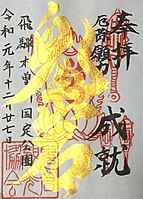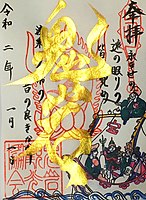Oniiwa Park
| Oniiwa Park | |
|---|---|
| 鬼岩公園 | |
 Lotus Flower Rock (蓮華岩, Renge-iwa) at Oniiwa Park | |
| Location | Mitake and Mizunami, Gifu |
| Coordinates | 35°24′45.08″N 137°11′56.86″E / 35.4125222°N 137.1991278°E |
| Open | All year |
| Website | http://www.oniiwaonsen.com/kouenannai.htm |
Oniiwa Park (鬼岩公園, Oniiwa Kōen) is a park on the border of Mitake, Kani District and Mizunami in Gifu Prefecture, Japan. It is located in Hida-Kisogawa Quasi-National Park. Oniiwa is a Japanese government designated Place of Scenic Beauty and Natural Monument.[1][2]
Overview[edit]

It is located near the source of the Kani River, a tributary of the Kiso River. It has massive granite rocks that have been eroded over a period of millions of years.[3] There are also many rhododendrons and Japanese maples, and it is a famous spot for foliage in autumn[note 1]. Near the Eboshi-iwa (烏帽子岩) summit, a waterfall will appear a few times a year after heavy rainfall.[5]
Oniiwa Onsen, a sulfur and uranium mineral spring, is nearby.
It was discovered in 2016 that rock climbing wedges had been driven into rocks at Oniiwa Park within Mitake. The Japan Free Climbing Association, as well as meeting with the town of Mitake, Gifu, and the Agency for Cultural Affairs, performed work on March 27, 2018 to remove the wedges or otherwise to repair the places where the wedges could not be removed.[6]
Origin of the name "Oniiwa"[edit]
The legend is that there was a demon named Seki no Tarō (関の太郎) who lived in the area, and so it came to be called Demon Rock (鬼岩, Oniiwa). Seki no Tarō lived around the year 1200, and terrorized residents and travelers on the Tōsandō with evil deeds. He was killed by soldiers dispatched under the orders of Emperor Go-Shirakawa. Other than Oniiwa, there are places with names connected to the legend like Demon's Grotto (鬼の岩屋, Oni no Iwaya), where the oni lived, or Demon's Severed Heads Burial Mound (鬼の首塚, Oni no Kubizuka), where the heads of slain oni were buried, as well as Tarō's Rock (太郎岩, Tarō Iwa), Chopping Board Rock (まな板岩, Manaita Iwa), Head-washing Pond (首洗池, Kubiarai Ike) and others.[7]
Fukuoni Matsuri[edit]

A Setsubun festival that has been held since 1986 on the first Sunday in February, around February 3.[8] The legend goes that Seki no Taro was exorcised and resurrected as a good-luck demon. So that the demons will bring good luck, when scattering beans, instead of the normal chant, everyone says "Demons in! Good luck in!" (鬼は内!福は内!, Oni wa uchi! Fuku wa uchi!).
![]() Media related to Oni-iwa Park at Wikimedia Commons
Media related to Oni-iwa Park at Wikimedia Commons
Goshuin[edit]
Planned by the Gifu Community Development Association's Hitohito Association. As of November 2019 Oniiwa Park is one of 13 places[note 2] that have "Golden Goshuin".[10] These are special goshuin decorated with gold that are only available on the last Friday of each month, or "Premium Friday". They are issued at the goshuin booth in Oniiwa Drive-in.[11][12] It uses a proprietary ink that looks gold from the front and red from the back.[11][12]
- Golden goshuin from Oniiwa Drive-in
-
Received December 27, 2019
-
Received December 27, 2019
-
Received January 1, 2020
Access[edit]
If by train, take a taxi from either Mitake Station on the Meitetsu Hiromi Line or Tokishi Station on the JR Chūō Main Line. A bus operated by Tohtetsu is no longer running. If by highway, get off the Chūō Expressway at Toki IC or the Tōkai-Kanjō Expressway at Kani-Mitake IC and then to Route 21.
Footnotes[edit]
Notes[edit]
- ^ In 2004, it was voted by prefectural residents and tourists to be in the "33 Famous Places for Foliage".[4]
- ^ Kogane Shrine, Gyokushoin, Gifu Nobunaga Shrine (Kenkun Shrine), Kobuji, Osshinji, Inaba Shrine, Gifu Castle, Tenryū-ji (Kani), Seki Zenkō-ji, Gokokushi-ji, Shinchoji, Oniiwa Park, Gujō Hachiman Castle.[9]
References[edit]
- ^ "鬼岩". 国指定文化財等データベース (in Japanese). Agency for Cultural Affairs. Retrieved 11 February 2020.
- ^ "鬼岩 文化遺産オンライン". Cultural Heritage Online (in Japanese). Agency for Cultural Affairs. Retrieved 11 February 2020.
- ^ "巨岩怪石織り成す景勝地" Yomiuri Shimbun 2019-8-22 morning p. 23
- ^ "紅葉名所県内33選" Gifu Shimbun 2004-10-20 p. 21
- ^ "幻の滝出現 鬼岩公園の烏帽子岩山頂付近" Gifu Shimbun 2006-7-23 p. 23
- ^ "岐阜県鬼岩についての報道の件について". Japan Free Climbing Association (in Japanese). 16 June 2016. Retrieved 10 February 2020.
- ^ "鬼岩公園". 瑞浪市観光協会. 瑞浪市観光協会. 31 July 2019. Retrieved 10 February 2020.
- ^ "Yearly Events". Oniiwa Onsen Travel Navigator. Oniiwa Onsen Tourism Association. Retrieved 2019-12-25.
- ^ "Map of all 13 Gifu "Golden Goshuin"". Yukko Yanagase Official Blog. Ameba. 2019-11-28. Retrieved 2020-01-11.
- ^ "『金の御朱印』広がり次々 県内『金運の聖地』13ヶ所に 郡上八幡城で新たに授与" Chunichi Shimbun Morning Edition 2019-11-28 edition page 19
- ^ a b 「刷新し『金の御朱印』 鬼岩観光協が発行 岐阜・金神社にならい 月末の金曜日のみ発行」Chunichi Shimbun Morning Edition 2019-11-29 edition p. 19
- ^ a b "キラキラ鬼岩御朱印 瑞浪市 あすからリニューアル" Gifu Shimbun Morning 2019-11-28 edition




